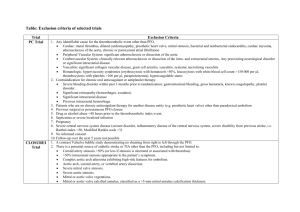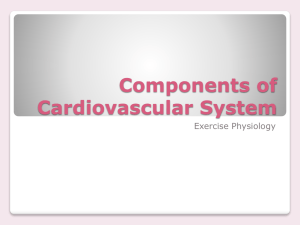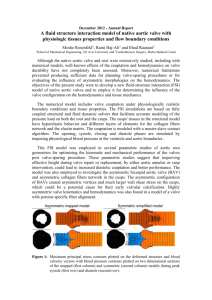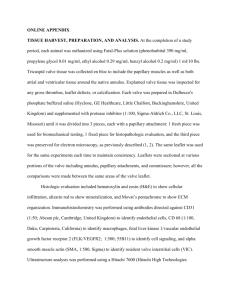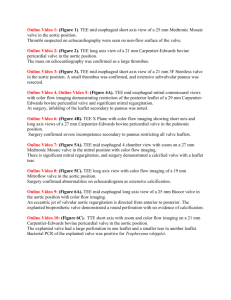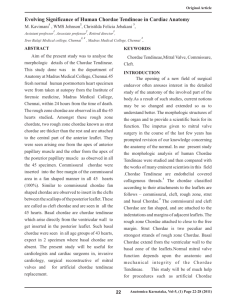Scientific advisor
advertisement
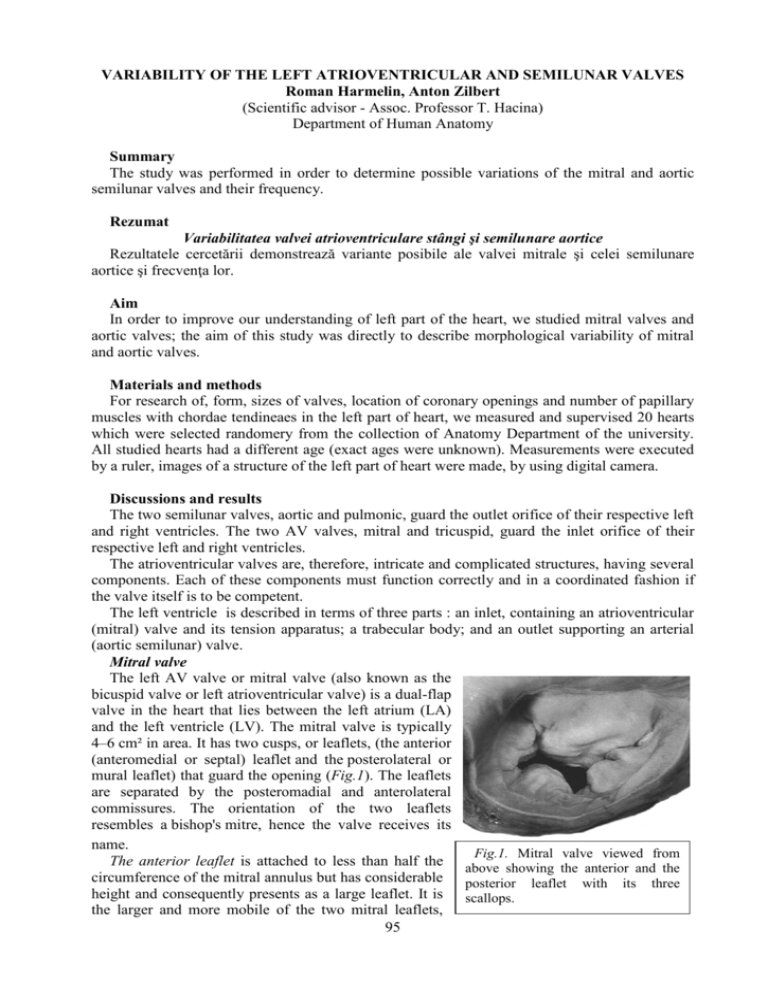
VARIABILITY OF THE LEFT ATRIOVENTRICULAR AND SEMILUNAR VALVES Roman Harmelin, Anton Zilbert (Scientific advisor - Assoc. Professor T. Hacina) Department of Human Anatomy Summary The study was performed in order to determine possible variations of the mitral and aortic semilunar valves and their frequency. Rezumat Variabilitatea valvei atrioventriculare stângi şi semilunare aortice Rezultatele cercetării demonstrează variante posibile ale valvei mitrale şi celei semilunare aortice şi frecvenţa lor. Aim In order to improve our understanding of left part of the heart, we studied mitral valves and aortic valves; the aim of this study was directly to describe morphological variability of mitral and aortic valves. Materials and methods For research of, form, sizes of valves, location of coronary openings and number of papillary muscles with chordae tendineaes in the left part of heart, we measured and supervised 20 hearts which were selected randomery from the collection of Anatomy Department of the university. All studied hearts had a different age (exact ages were unknown). Measurements were executed by a ruler, images of a structure of the left part of heart were made, by using digital camera. Discussions and results The two semilunar valves, aortic and pulmonic, guard the outlet orifice of their respective left and right ventricles. The two AV valves, mitral and tricuspid, guard the inlet orifice of their respective left and right ventricles. The atrioventricular valves are, therefore, intricate and complicated structures, having several components. Each of these components must function correctly and in a coordinated fashion if the valve itself is to be competent. The left ventricle is described in terms of three parts : an inlet, containing an atrioventricular (mitral) valve and its tension apparatus; a trabecular body; and an outlet supporting an arterial (aortic semilunar) valve. Mitral valve The left AV valve or mitral valve (also known as the bicuspid valve or left atrioventricular valve) is a dual-flap valve in the heart that lies between the left atrium (LA) and the left ventricle (LV). The mitral valve is typically 4–6 cm² in area. It has two cusps, or leaflets, (the anterior (anteromedial or septal) leaflet and the posterolateral or mural leaflet) that guard the opening (Fig.1). The leaflets are separated by the posteromadial and anterolateral commissures. The orientation of the two leaflets resembles a bishop's mitre, hence the valve receives its name. Fig.1. Mitral valve viewed from The anterior leaflet is attached to less than half the above showing the anterior and the circumference of the mitral annulus but has considerable posterior leaflet with its three height and consequently presents as a large leaflet. It is scallops. the larger and more mobile of the two mitral leaflets, 95 extends from the top of the posteromedial septum across the ventricular cavity to the anterolateral ventricular wall and separates the left ventricular cavity into an inflow and an outflow tract. The funnel-shaped inflow tract, which is formed by the mitral annulus and by both mitral leaflets and their chordae tendineae, directs the entering atrial blood inferiorly, anteriorly, and to the left. The outflow tract, surrounded by the inferior surface of the anteromedial mitral leaflet, the ventricular septum, and the left ventricular free wall, orients the blood flow from left ventricular apex to the right and superiorly at an angle of 90° to the inflow tract. With the onset of ventricular systole, both mitral leaflets are propelled together and upward, converting the entire left ventricle into an expulsion chamber. The apical portion of the left ventricle is characterized by fine trabeculations. The anterior cusp protects approximately two-thirds of the valve. Note that although the anterior leaflet takes up a larger part of the ring and rises higher, the posterior leaflet has a larger surface area. These valve leaflets are prevented from prolapsing into the left atrium by the action of tendons attached to the posterior surface of the valve, chordae tendineae. Chordae Tendineae Strong cords of fibrous tissue, the chordae tendineae, spring from the tip of each papillary muscle. They often subdivide and interconnect before they attach to the two leaflets directly above. The chordae may attach directly into a fibrous band running along the free edge of the valves or they may become incorporated into the ventricular surface of the leaflet a few millimeters back from the edge. Additional chordae run directly from the ventricular wall into the undersurface of the posterolateral leaflet of the left ventricle. The chordae tendineae, by their attachments to most of the free valvular border and by their numerous cross connections, allow the valve leaflets to balloon upward and against each other and evenly distribute the forces of ventricular systole. Dysfunction or rupture of a papillary muscle or rupture of a chorda tendinea may undermine the support of one or more valve leaflets, producing regurgitation. The posterior leaflet, in contrast, is attached to more than half the circumference but is less tall , and occupies only about the same area as the anterior leaflet. Moreover, the posterior leaflet has a characteristic scalloped contour. In the usual case three scallops can be distinguished divided by clefts. These scallops are termed posteromedial, middle and anterolateral. The large the variation in the number of scallops exists. In 15% of cases 4-6 scallops being seen in otherwise normal valves were found, in 3% two scallops only. The mitral valve leaflets are supported by two papillary muscles situated underneath the commissural areas in the posteromedial and anterolateral positions. Their position is such that the chordae between muscle and leaflet operate at the maximal mechanical efficiency. Each papillary muscle supports the adjacent part of both valve leaflets. Papillary muscles The papillary muscles are located below the commissures of the AV valves. These muscles project from the trabeculae carneae. In the left ventricle the two groups of papillary muscles, located below the anterolateral and posteromedial commissures, arise from the junction of the apical Fig.2. Fan-like papillary muscles. and middle third of the ventricular wall. The 96 papillary muscles, because of their relatively parallel alignment to the ventricular wall and their chordal attachments to two adjacent valve leaflets, pull the leaflets of the valve together and downward at the onset of isovolumic ventricular contraction. There is considerable variation in the morphology of the papillary muscles themselves, particularly the posteromedial muscle (Fig.2). They may be single pillar-like muscles, bifid or be composed of several heads of different size (fan-like papillary muscles). The different papillary muscle architecture affects the chordal distribution (vide infra) and also affects the mode of the arterial supply to the papillary muscle complex. Because of the different topography of the anterior and the posterior leaflets, there are corresponding differences in the mode of chordal support, which also show considerable individual variation. The anterior leaflet is supported only by rough zone chordae together with the commissural chords. The rough zone chords may be strengthened by thicker tendinous structures, the socalled strut chordae, usually one for each half of the leaflet. The commissural chords spring from the tips of their papillary muscle and fan out to attach to the free margins of both leaflets. The posteromedial commissural chord usually fans out more than that of the anterolateral commissure. As with the aortic valve, mitral valve closes some distance away from its free edge. The inelastic chordae tendineae are attached at one end to the papillary muscles and the other to the valve cusps. Papillary muscles are fingerlike projections from the wall of the left ventricle. Chordae tendineae from each muscle are attached to both leaflets of the mitral valve. Thus, when the left ventricle contracts, the intraventricular pressure forces the valve to close, while the tendons keep the leaflets coapting together and prevent the valve from opening in the wrong direction (thus preventing blood to flow back to the left atrium). Each chord has a different thickness. The thinnest ones are attached to the free leaflet margin, whereas thickest ones are attached quite away from the free margin. This disposition has important effects on systolic stress distribution physiology. The major chordae supporting a leaflet insert either into its free edge, or the area beyond the free edge on the ventricular aspect up to the line of closure of the leaflet. This area between the free edge and the line of closure is termed the rough zone in contradistinction to the area between the line of closure and the basal attachment of the leaflet which is easily transilluminated and is smooth. It is important to remember that the line of closure of a leaflet is not its free edge. The major chordae supporting a leaflet insert either into its free edge, or the area beyond the free edge on the ventricular aspect up to the line of closure of the leaflet. This area between the free edge and the line of closure is termed the rough zone. The chordae inserted into the rough zone are called rough zone chordae. They are distinguished from basal chordae which pass from the ventricular myocardium to the ventricular aspect of the leaflet close to its attachment and commissural chordae which are the discrete fanshaped chordae inserting into the free margin of the leaflet only and supporting two adjacent leaflets. Abnormalities of the mitral valve: - Mitral Valve Prolapse: is when one or both valve flaps are enlarged. As a result, when the heart pumps, the mitral valve flaps don't close smoothly and may not seal tightly. Instead, they may collapse backward into the left atrium. This sometimes causes regurgitation. - Mitral Valve Regurgitation: is when the mitral valve does not close well and blood leaks back into the left atrium from the left ventricle. This causes the atrium to get bigger. Then it cannot squeeze as effectively as it should. - Mitral Valve Stenosis: is when the valve becomes narrow or tight. This makes it hard for the blood to get through to the left ventricle. As a result, blood can back up in the blood vessels of the lungs. Stenosis can also cause regurgitation. The aortic semilunar valve is one of the valves of the heart. It is normally tricuspid (with three leaflets), (in 1% of the population it is found to be congenitally bicuspid) . It lies between the left ventricle and the aorta. 97 The semilunar aortic and pulmonary valves are similar in configuration, except the aortic cusps are slightly thicker. Each valve is composed of the three fibrous cusps. The U-shaped convex lower edges of each cusp are attached to and suspended from the root of the aorta or pulmonary artery, with the upper free valve edges projecting into the lumen. The cusps circle the inside of the vessel root. Aortic semilunar valve consists of three equal-sized or nearly equal-sized semicircular cusps. Each cusp is attached by its semicircular border to the wall of the aorta. The small space between attachments of adjacent cusps is called a commissure. The semilunar valve has three commissures. The three commissures lie equally spaced around the aorta, and the circumference connecting these points has been termed the sinotubular junction, which may also be described as the portion of the great vessel separating the sinuses of Valsalva from the adjacent tubular portion of the great artery. Each of the ventricular surfaces of the semilunar cusps has a small nodule (noduli Arantii) in the center of the free edge marking the contact sites of closure. Behind each cusp the vessel wall bulges outward, forming a pouchlike dilatation known as the sinus of Valsalva. The free edge of each cusp is concave, with a nodular interruption at the center of the cusp, the nodulus Arantii. The portion of the cusp adjacent to the rim is not as thick and may normally contain small perforations (Fig.3). Fig.3. Perforations of the right (a) and left (c) cusps of the aortic valve During ventricular systole, the cusps are passively thrust upward away from the center of the aortic lumen. During ventricular diastole, the cusps fall passively into the lumen of the vessel as they support the column of blood above. The noduli Arantii meet in the center and contribute to the support of the leaflets. The geometry of the cusps and the strong fibrous tissue support provide excellent approximations of the cusps and prevent regurgitation of blood. The aortic valve closes at some distance away from its free edge. The area between the line of closure and the free edge in 15% of cases is fenestrated. Abnormalities of aortic valve: - Aortic stenosis: in which the valve fails to open fully, thereby obstructing blood flow out from the heart.It can be caused as a result of rheumatic fever, degenerative calcification, and congenital diseases such as bicuspid aortic valve. - Aortic insufficiency, also called aortic regurgitation: in which the aortic valve is incompetent and blood flows passively back to the heart in the wrong direction. It can be caused as a result of aortic regurgitation include dilation of the aorta, previous rheumatic fever, infection, i.e. infective endocarditis, myxomatous degeneration of the aortic valve, and Marfan's syndrome. Bicuspid aortic valve: is the most common congenital abnormality of the heart, in this condition, - instead of three cusps, the aortic valve has two cusps. 98 Conclusions 1. The valvular apparatus of the left heart shows the large individual variability. 2. A number of studies have shown: a) variability of size of the casps; b) variability of the number of the chordae tendineae; c) difference in the position of the coronary foramina; d) the presence of additional skullops; e) presence of clefts and perforations of the leaflets. 1. 2. 3. 4. 5. Bibliography Kasyanov V. A., B. A. Purinya B. A.and Ose V. P. . Structure and mechanical properties of the human aortic valve. Mechanics of composite materials. Volume 20, Number 5 (1985), 637-647. Nayar S., Nayar P.G., Kherian K.M.. Heart valve structure: a predisposing factor for rheumatic heart disease. Heart, 2006, 92: 1151-1152. Patil D., Mehta C., Prajapati P.. Morphology of Mitral valve in Human cadavers. The Internet Journal of Cardiology. 2009 Volume 7, Number 2. Robert B. Hinton and Katherine E. Yutzey. Heart Valve Structure and Function in Development and Disease Annual Review of Physiology, 2011, Vol. 73: 29-46. Thubrikar M., Nolan S.P., Bosher L.P., Deck J.D. The cyclic changes and structure of the base of the aortic valve. Am Heart J 1980;99:217-24. 99

